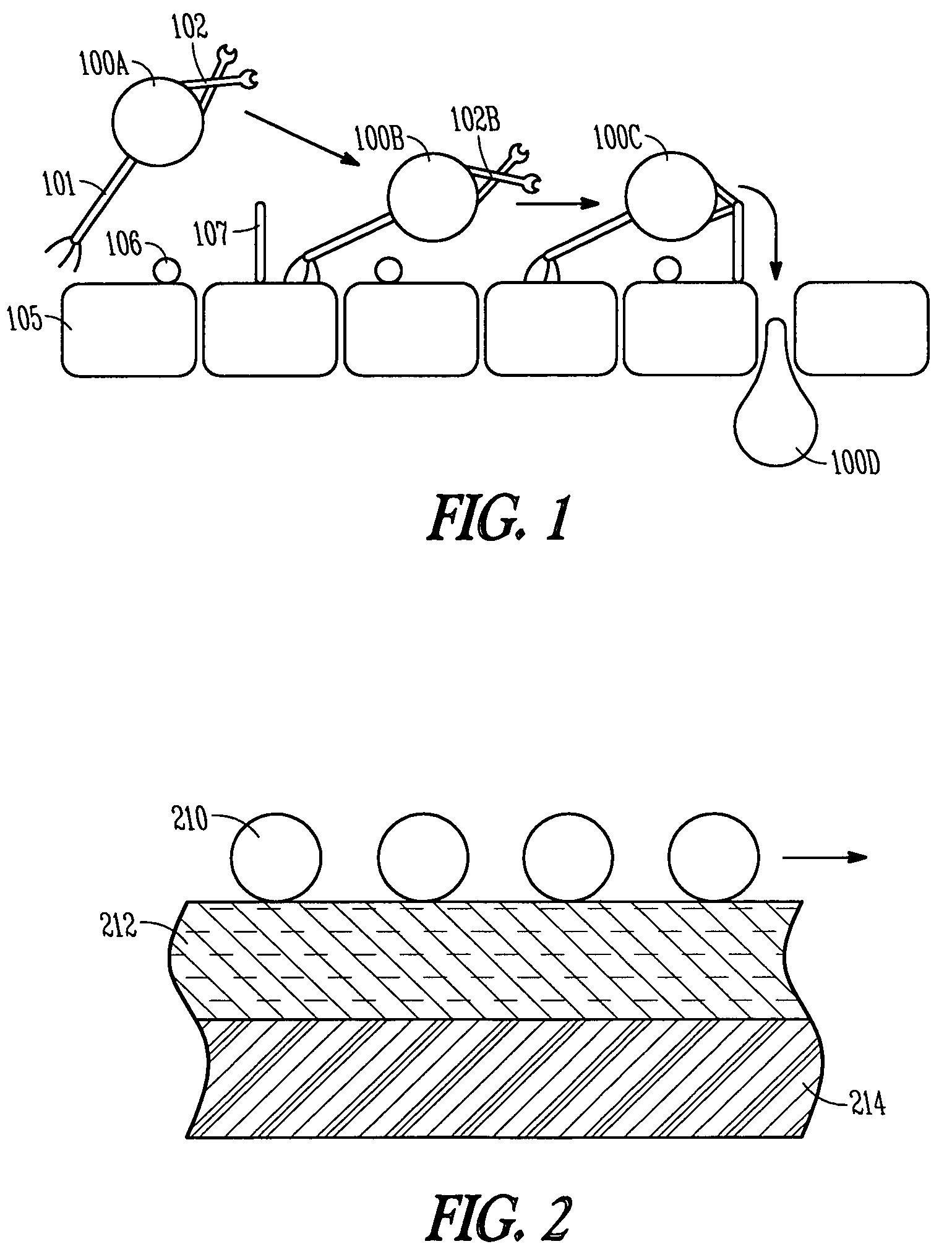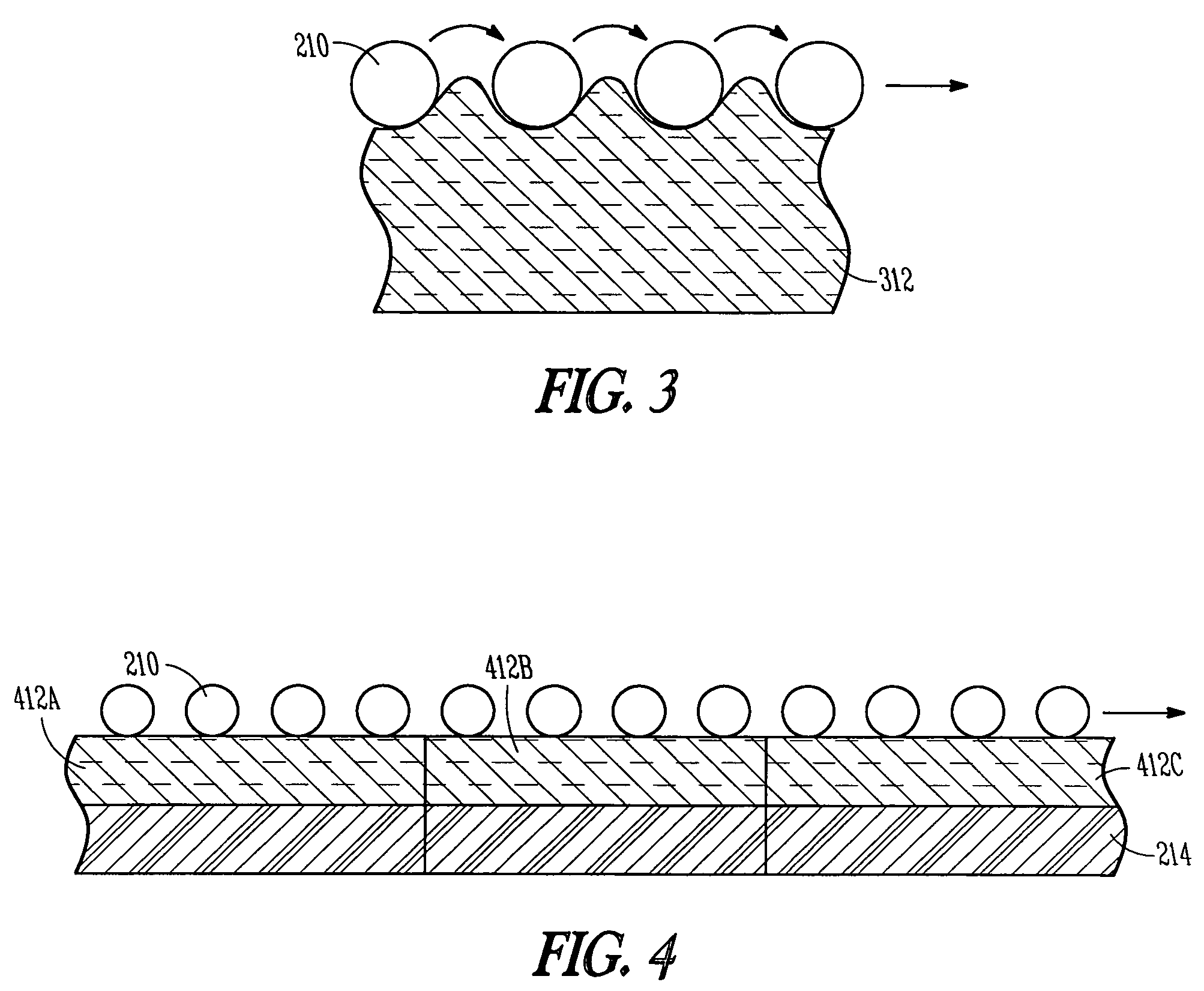[0007]In one embodiment, the invention provides a
system including a device, e.g., one adapted to deliver donor cells, and a
population of donor cells having increased expression or activation of one or more adhesion molecules, e.g., as a result of contact with the device which may be coated or embedded with, or both, an agent that increases expression or activation of adhesion molecules on the donor cells, or as a result of contact with the agent
in vitro. For example, the inside lumen of a
catheter may be lined with one or more agents, e.g.,
a peptide, that activate adhesion molecules,
on cells that are useful for
cell therapy. Thus, adhesion molecules on donor cells in the lumen of a
catheter are activated by their interaction with the agents lining the lumen of the catheter, e.g., during delivery of the cells. In one embodiment, the one or more agents are linked to the device, e.g., using a
linker such as a
polyethylene glycol (PEG) based
linker. In one embodiment, the agent coated on or embedded in the device is not an
antibody. In another embodiment, donor cells are contacted
ex vivo with a device with a
surface modified to activate or enhance expression of adhesion molecules.
[0008]In another embodiment, the invention provides a method to enhance
donor cell homing in a
mammal subjected to
cell therapy. The method includes delivering to a
mammal in need of
cell therapy donor cells and an effective amount of a composition comprising an agent that increases the amount or activation of endogenous adhesion molecules on endothelial cells in the
mammal. The present invention thus provides for increased homing and retention of transplanted donor cells by manipulating the expression of adhesion molecules on endogenous tissue, e.g., endothelial cells. The increased expression allows for increased homing of donor cells to particular sites, for instance, sites of
inflammation, thus increasing the
efficacy of cell therapy. For instance, the agent may be a
cytokine, e.g., IL-8, IL-6 or TNF-α, or other molecule, e.g.,
lipopolysaccharide (LPS) or dimethylsulfoxide (DMSO), or a combination thereof. In one embodiment, the agent is not an
antibody.
[0010]In one embodiment, the present invention provides for increased homing and retention of transplanted cells by manipulating the expression of adhesion molecules on donor cells, e.g., donor stem cells, or donor cells and endogenous tissue, e.g., endothelial cells, to allow for increased homing of donor cells to particular sites, for instance, sites of
inflammation, thus increasing the
efficacy of cell therapy. In order for cells to extravasate from the circulation and home to a specific site, they must make contact with the vessel wall, break their motion and firmly adhere.
[0012]In one embodiment, the
donor cell is a
stem cell having an
antigen including but not limited to CD34, CD133, ABCG2, Sca-1, Stro-1, Nestin, PSA-NCam, p75
neurotrophin, c-kit, CD30, and the like. In one embodiment, the agent includes but is not limited to an agent that modulates inflammatory markers or adhesion molecules, e.g., VAP-1, P-
selectin, E-
selectin, ICAM, vascular cellular adhesion molecule (VCAM), vascular leukocyte adhesion (VLA), etc., and soluble forms thereof. The agent may be contacted with an endogenous tissue or cells, such as cardiac tissue,
pancreatic tissue, neuronal cells, microglial cells, and
synovial fluid secreting cells, donor cells, or both. In one embodiment, the methods of the invention are used for the repopulation of destroyed cells, for instance, in an organ in need of repair, for example, kidneys, liver, heart, lungs, intestines and the like, which may be highly advantageous in patients suffering from
spinal cord trauma, diabetes,
organ damage, or Alzheimer's
disease.
[0013]In another embodiment, agents that inhibit or block binding of endogenous circulating cells, e.g., stem cells, are employed to decrease endogenous cell implantation at a selected site. For example, VAP-1 inhibitors, e.g.,
semicarbazide sensitive
amine oxidase (SSAO) inhibitors, may be employed. The delivery of VAP-1 inhibitors, e.g., via a
stent, in an effective amount may inhibit
inflammation,
restenosis,
oxidative stress, e.g.,
reactive oxygen species (ROS) production, or a combination thereof. In one embodiment, the VAP-1 inhibitor may be an
antibody, e.g., a humanized, chimeric, or ScFv antibody. In another embodiment, the VAP-1 inhibitor is not an antibody, for instance, the VAP-1 inhibitor is a
drug containing a hydrazine, arylalkylamine, propenylamine, proparylamine, oxazolidinone or haloalkylamine. In one embodiment, one or more VAP-1 inhibitors are combined with a carrier such as a
polymer,
phosphorylcholine, or a
ceramic, to provide for sustained release of the one or more inhibitors. In one embodiment, the one or more VAP-1 inhibitors are administered along with an immunosuppressive and / or an antiproliferative, for instance,
sirolimus (rapamycin),
paclitaxel, zotarolimus or
everolimus. The immunosuppressive or antiproliferative may be administered separately or via the same
delivery vehicle as the VAP-1 inhibitor, e.g., via the same
stent or lead, to the same mammal.
 Login to View More
Login to View More 


